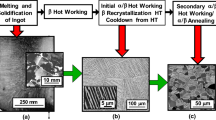Abstract
microstructures with maximum resistance to fatigue crack extension while maintaining high strength levels. A wide range of crack growth rates has been examined, from ~10-8 to 10-3 mm per cycle, in a series of duplex microstructures of comparable yield strength and prior austenite grain size where intercritical heat treatments were used to vary the proportion, morphology, and distribution of the ferrite and martensite phases. Results of fatigue crack propagation tests, conducted on “long cracks” in room temperature moist air environments, revealed a very large influence of microstructure over the entire spectrum of growth rates at low load ratios. Similar trends were observed at high load ratio, although the extent of the microstructural effects on crack growth behavior was significantly less marked. Specifically, microstructures containing fine globular or coarse martensite in a coarse-grained ferritic matrix demonstrated exceptionally high resistance to crack growth without loss in strength properties. To our knowledge, these microstructures yielded the highest ambient temperature fatigue threshold stress intensity range ΔK0 values reported to date, and certainly the highest combination of strength and ΔK0 for steels (i.e., ΔK0 values above 19 MPa√m with yield strengths in excess of 600 MPa). Such unusually high crack growth resistance is attributed primarily to a tortuous morphology of crack path which results in a reduction in the crack driving force from crack deflection and roughness-induced crack closure mechanisms. Quantitative metallography and experimental crack closure measurements, applied to currently available analytical models for the deflection and closure processes, are presented to substantiate such interpretations.
Similar content being viewed by others
References
R.O. Ritchie:Int. Metall. Rev., 1979, vol. 20, p. 205.
J. Masounave and J.-P. Ballon:Scripta Met., 1976, vol. 10, p. 165.
R.O. Ritchie:Metal Science, 1977, vol. 11, p. 368.
J.P. Lucas and W.W. Gerberich:Mater. Sci. Eng., 1981, vol. 51, p. 203.
S. Suresh, G. F. Zamiski, and R.O. Ritchie: inApplication of 21/4Cr-1Mo Steel for Thick Wall Pressure Vessels, ASTM STP 755, G. S. Sangdahl and M. Semchyshen, eds., American Society for Testing and Materials, Philadelphia, PA, 1982, pp. 49–67.
R.O. Ritchie and S. Suresh:Metall. Trans. A, 1982, vol. 13A, p. 937.
G. T. Gray, A. W. Thompson, and J. Williams:Metall. Trans. A, 1983, vol. 14A, p. 421.
S. Suresh and R. O. Ritchie:Int. Metall. Rev., 1984, vol. 25, in press.
J. Y. Koo and G. Thomas:Metall. Trans. A, 1977, vol. 8A, p. 525.
Y. Tomota, N. Tachibana, and K. Kuroki:Trans. ISIJ, 1978, vol. 18, p. 251.
G. R. Speich: inFundamentals of Dual-Phase Steel, R. A. Kot and B. L. Bramfitt, eds., The Metallurgical Society of AIME, Warrendale, PA, 1981, p. 3.
R.G. Davies:Metall. Trans. A, 1978, vol. 9A, p. 41.
N. J. Kim and G. Thomas:Metall. Trans. A, 1981, vol. 12A, p. 483.
H. Suzuki and A.J. McEvily:Metall. Trans. A, 1979, vol. 10A, p. 475.
K. Minakawa, Y. Matsuo, and A. J. McEvily:Metall. Trans. A, 1982, vol. 13A, p. 439.
N. Walker and J. Beevers:Fat. Eng. Mat. Struct., 1979, vol. 1, p. 135.
K. Minakawa and A. J. McEvily:Scripta Met., 1981, vol. 15, p. 633.
I.C. Mayes and T.J. Baker:Fat. Eng. Mat. Struct., 1981, vol. 4, p. 79.
S. Suresh and R.O. Ritchie:Metall. Trans. A, 1982, vol. 13A, p. 1627.
J.A. Wasynczuk, R.O. Ritchie, and G. Thomas:Mater. Sci. Eng., 1984, vol. 62, p. 79.
T. Kunio and K. Yamada: inFatigue Mechanisms, ASTM STP 675, J. T. Fong, ed., American Society for Testing and Materials, Philadelphia, PA, 1979, pp. 342–61.
T. Kunio, M. Shimizu, K. Yamada, and H. Nakabayashi: inFatigue Thresholds, J. Bäcklund, A. Blom, and J. Beevers, eds., EMAS Ltd., Warley, U.K., 1982, vol. 1, pp. 409–22.
K. Yamada: Discussion inFatigue Mechanisms, ASTM STP 675, J. T. Fong, ed., American Society for Testing and Materials, Philadelphia, PA, 1979, p. 367.
T. Ishihara: inMechanical Behavior of Materials-IV, Proceedings of Fourth Intl. Conf. (ICM-4), Stockholm, Sweden, J. Carlsson and N.G. Ohlson, eds., Pergamon Press, New York, NY, 1983, vol. 2, p. 1155.
R.J. Bucci: inFracture Mechanics (13th Conference), ASTM STP 743, American Society for Testing and Materials, Philadelphia, PA, 1981, p. 28.
P.K. Liaw, T. R. Leax, R. S. Williams, and M.G. Peck:Metall. Trans. A, 1982, vol. 13A, p. 1607.
W.W. Gerberich, W. Yu, and K. Esaklul:Metall. Trans. A, 1984, vol. 15A, p. 875.
G. Birkbeck, A. E. Inckle, and G. W. J. Waldron:J. Mat. Sci., 1971, vol. 6, p. 319.
R.O. Ritchie and J.F. Knott:Acta Metall., 1973, vol. 21, p. 639.
S. Suresh:Metall. Trans. A, 1983, vol. 14A, p. 2375.
W. Elber:Eng. Fract. Mech., 1970, vol. 2, p. 37.
R.O. Ritchie, S. Suresh, and C. M. Moss:J. Eng. Matls. Tech., Trans. ASME Series H, 1980, vol. 102, p. 293.
A.T. Stewart:Eng. Fract. Mech., 1980, vol. 13, p. 463.
S. Suresh, G. F. Zamiski, and R. O. Ritchie:Metall. Trans. A, 1981, vol. 12A, p. 1435.
D.L. Davidson:Fat. Eng. Mat. Struct., 1981, vol. 3, p. 229.
S. Suresh: Brown University, Report No. E-153, March dy1984, submitted toMetall. Trans. A.
J.F. McCarver and R.O. Ritchie:Mater. Sci. Eng., 1982, vol. 55, p. 63.
C.E. Richards and T.C. Lindley:Eng. Fract. Mech., 1972, vol. 4, p. 951.
R.O. Ritchie and J.F. Knott:Mater. Sci. Eng., 1974, vol. 14, p. 7.
Author information
Authors and Affiliations
Additional information
Formerly Lecturer and Research Engineer in the Department of Materials Science and Mineral Engineering, University of California
Rights and permissions
About this article
Cite this article
Dutta, V.B., Suresh, S. & Ritchie, R.O. Fatigue crack propagation in dual-phase steels: Effects of ferritic-martensitic microstructures on crack path morphology. Metall Trans A 15, 1193–1207 (1984). https://doi.org/10.1007/BF02644714
Received:
Published:
Issue Date:
DOI: https://doi.org/10.1007/BF02644714




